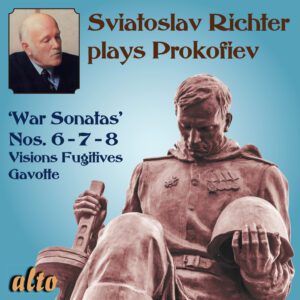Out of eleven issued live recordings of Richter playing Sonata No. 6, Alto opts for the same October 6, 1956 Moscow performance released by Parnassus. The sound pales next to the professionally recorded RCA 1960 Carnegie Hall or Philips 1966 Locarno editions, but the outer movements press ahead more impetuously. Still, I’d prefer to hear the pianist’s expansive phrasing and hypnotic legato in the Tempo di Valzer minus sonic fuzz.
Considering that Richter professed a fear of microphones and once likened the recording process to a torture chamber, he did some of his finest work under studio conditions. His 1958 Melodiya Sonata No. 7 is a triumphant case in point, from its bracing and unrelenting first movement to a Precipato finale that gathers assiduous momentum, even speeding up a bit in the final climactic pages.
Alto includes the 1961 Deutsche Grammophon studio Prokofiev Sonata No. 8, easily the best sonic representation of Richter in this work, and again, one of Richter’s many studio triumphs. His deliberate basic tempo for the long first movement allows listeners to savor and absorb Prokofiev’s melodic bounty, while the central Andante sognando has a sense of flow and lilt absent from the pianist’s faster and less patient October 1960 Carnegie Hall performance. The finale features decisive pointing of the first theme’s rapid passagework, and the lyrical minor-key episode both incisively articulated and gorgeously pedaled. That said, I generally prefer lighter, more whimsical interpretations, as in Steven Osborne’s recent Hyperion recording.
The Visions Fugitives and Gavotte fillers from 1956 need no special commentary, except that the Gavotte is faster and bouncier compared alongside the suaver elegance of the live 1979 Salzburg recording included in the Philips “Authorized Recordings” collection. Variable sonics aside, you can’t go wrong with Richter in his prime playing Prokofiev.
































